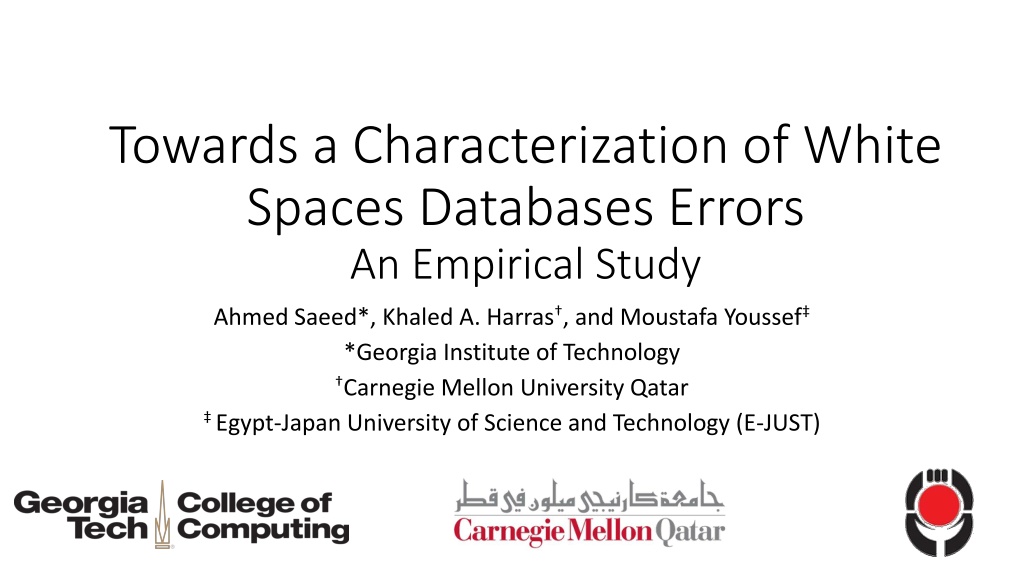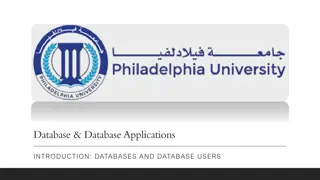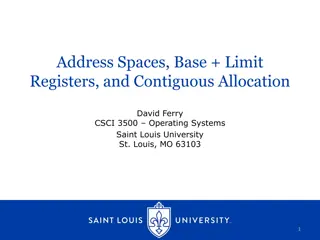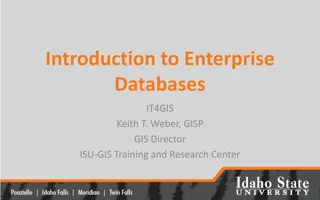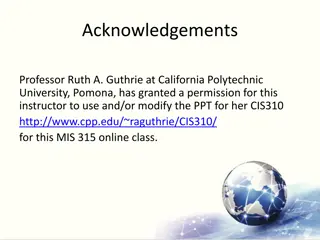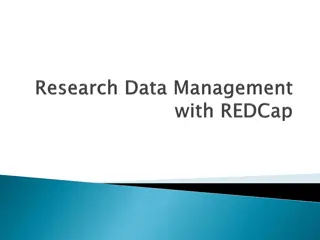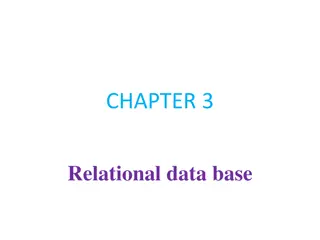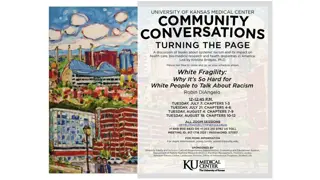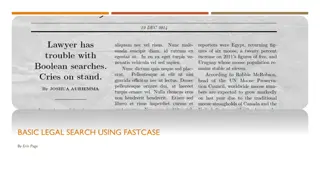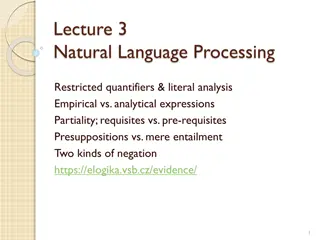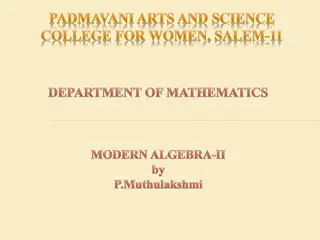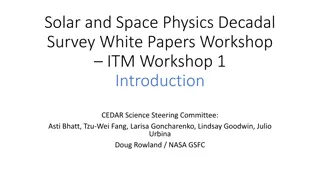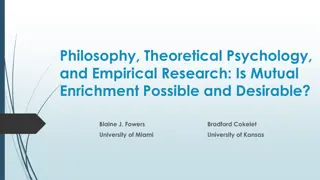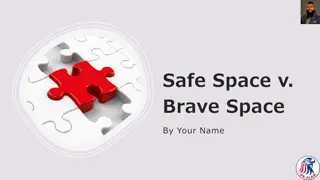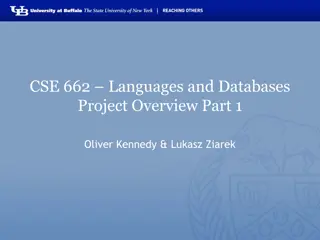Understanding White Spaces Databases: An Empirical Study
White spaces in the TV band offer opportunities for unlicensed usage, motivating research on white space detection methods like geolocation spectrum databases and spectrum sensing. This study explores errors in white spaces databases, discussing the challenges and implications for white space devices. By examining the effectiveness of different detection methods, the study sheds light on improving spectrum utilization in urban environments.
Download Presentation

Please find below an Image/Link to download the presentation.
The content on the website is provided AS IS for your information and personal use only. It may not be sold, licensed, or shared on other websites without obtaining consent from the author. Download presentation by click this link. If you encounter any issues during the download, it is possible that the publisher has removed the file from their server.
E N D
Presentation Transcript
Towards a Characterization of White Spaces Databases Errors An Empirical Study Ahmed Saeed*, Khaled A. Harras , and Moustafa Youssef *Georgia Institute of Technology Carnegie Mellon University Qatar Egypt-Japan University of Science and Technology (E-JUST)
Outline Introduction A Large Scale Urban Study When to Use Spectrum Sensing? SPOC: Signal Prediction & Observation Combiner Conclusion and Future Work
Outline Introduction A Large Scale Urban Study When to Use Spectrum Sensing? SPOC: Signal Prediction & Observation Combiner Conclusion and Future Work
Introduction White spaces are frequencies in the TV band that are not used by licensed services FCC ruling in 2008 enabling unlicensed usage of white spaces which motivated research on white space detecting and utilization White space detection methods help White Space Devices (WSDs) know if they lie in the protected area (coverage area) of nearby TV stations Current regulations specify two main ways for detecting white space opportunities Geo-location spectrum databases that rely on empirically constructed propagation models Spectrum sensing for detecting incumbents activity that require sensing at a sensing threshold of -114dbm which requires complex and expensive sensing devices
Introduction Geo-location Spectrum Databases Assumes comprehensive database of all TV stations covering the area of interest and that each WSD knows its location Propagation models use TV transmitter parameters to determine its protected area Earlier work by Murty et al. on Senseless Spectrum Database found the Longley-Rice model to be the most accurate model Longley-Rice model takes into statistical analyses of both terrain information and radio measurements data to better estimate signal propagation However, the L-R model does not perfectly match the collected measurements
Introduction Spectrum Sensing True coverage area Uses WSDs to detect the signal strength of TV transmitters Sensing at a threshold of near minimum decodable signal strength (i.e. -84 dBm) can cause the hidden node problem The hidden node problem occurs when an obstruction between the spectrum sensor and the TV station causes a miss detection of the channel occupied by the TV station TV Tower Area protected by spectrum sensing with a -84 dBm threshold
Introduction Spectrum Sensing (Cont d) Addressing the hidden node problem requires lowering the sensing threshold (-114 dbm) severely below the actual decodable signal strength values (-84 dbm) Using Low sensing thresholds ensures accurate detection of TV signal however overprotects the TV station just to avoid hidden node problems True coverage area TV Tower Area protected by spectrum sensing with protective threshold
Introduction Main Hypothesis Area protected by spectrum databases Area protected by spectrum sensing with a -84 dBm threshold Area protected by fusing both techniques
Goals Goals 1. Empirically study the accuracy of the Longley-Rice propagation model 2. Fuse both techniques to overcome their individual drawbacks and detect the actual protected area
Outline Introduction A Large Scale Urban Study When to Use Spectrum Sensing ? SPOC: Signal Prediction & Observation Combiner Conclusion and Future Work
A Large Scale Urban Study Introduction The accuracy of propagation models has gained attention recently In the work on V-Scope by Zhang et al. proposes the fusion of spectrum databases with and improved spectrum sensing approach shows a significant improvement in white space detection, yet still performs spectrum sensing at -114 dbm We conduct a large scale study to validate the accuracy of the Longley-Rice model and characterize cases where sensing can be performed with a sensing threshold of -84 dBm (minimum decodable TV signal strength)
A Large Scale Urban Study Methodology Area Covered Survey across the governorate of Alexandria, Egypt covered an area of around 3000 km2 with a driving path of 190 km The driving paths pass through areas with large buildings, desert, farm lands, at the edge of water bodies, and also across areas of different population densities
A Large Scale Urban Study Methodology - Setup A USRP N210 with a WBX 50- 2200 MHz Rx/Tx daughterboard and a log periodic LP0410 antenna connected to a Dell XPS-L502X laptop with a battery DC/AC power inverter as a power source. Location determination through a Garmin GLO GLONASS and GPS sensor.
A Large Scale Urban Study Methodology Data Collection We scanned the available 4 UHF TV channels available in the covered area Power readings were collected by centering the receiver's frequency at the middle of the luminance portion of the signal with a bandwidth of 250 KHz Energy detection was used as means of detection a TV station s presence The threshold used (and applied to propagation models as well) is -80dBm not -84 dBm due to the high noise floor on the USRP receiver.
A Large Scale Urban Study Observations We compare the collected readings with predictions of L-R model with and without terrain information Observation 1: The propagation model overestimates the signal strength up to 97.5% of the collected readings Observation 2: The measured RSS readings are correlated with predictions of the L-R model
Outline Introduction A Large Scale Urban Study When to Use Spectrum Sensing? SPOC: Signal Prediction & Observation Combiner Conclusion and Future Work
When to Use Spectrum Sensing? Introduction Crowdsourcing spectrum sensing at the -84 dBm threshold (the same threshold used to determine the protected area in a propagation model) can help amend the predictions of the propagation models We need to ensure that a spectrum sensor is not in a hidden node problem or malfunctioning Avoid the reason current regulations enforce the -114 dBm threshold We define a set of conditions that a spectrum sensory reading must satisfy in order to be used to amend the predictions of propagation models
When to Use Spectrum Sensing? Cases for Spectrum Sensory Readings Area protected by spectrum sensing at -114 dBm A spectrum sensory reading can be: Area protected by spectrum databases True negative: no TV reception can be made in its vicinity True coverage area False negative: malfunctioning nodes that can t detect a nearby TV station True positive: nodes that can detect a nearby TV station
When to Use Spectrum Sensing? Cases for Spectrum Sensory Readings A cluster of readings below the threshold near the border of the protected area of the TV station but has true positive reports in its vicinity A cluster of readings that are measured by malfunctioning nodes Two clusters of readings that are taken by nodes exhibiting a hidden node problem False negative detection of TV signal True negative detection of TV signal True positive detection of TV signal
When to Use Spectrum Sensing ? Conditions of Used Sensory Information (Cont d) Condition 1: Readings must be grouped into a co-located clusters with all readings contained in that clusters below the sensing threshold. Ensures that we have only small clusters of readings all confirming the same decision Ignores some noisy readings that give false negatives False negative reading False negative reading True negative reading True negative reading True positive reading True positive reading
When to Use Spectrum Sensing ? Conditions of Used Sensory Information (Cont d) Condition 2: Readings belonging to the same cluster must have a positive correlation with the modeling of the signal propagation in the area covered by the cluster (Observation 2). Detects some hidden node cases and the rest of noisy or malfunctioning clusters False negative reading False negative reading False negative reading True negative reading True negative reading True negative reading True positive reading True positive reading True positive reading
When to Use Spectrum Sensing ? Conditions of Used Sensory Information (Cont d) Condition 3: Clusters must not be fully enclosed within the protected area of the TV station covering their area. Detects the rest of hidden node problems by taking into account only the modeling mispredictions near the border of the protected area False negative reading False negative reading False negative reading True negative reading True negative reading True negative reading True positive reading True positive reading True positive reading
Outline Introduction A Large Scale Urban Study When to Use Spectrum Sensing ? SPOC: Signal Prediction & Observation Combiner Conclusion and Future Work
SPOC: Signal Prediction & Observation Combiner System Architecture WSDs communicate with SPOC servers through White Space Base Stations Base stations are connected to SPOC through the internet. WSDs can query SPOC for white spaces availability or submit their raw spectrum sensory readings no sensing threshold required all readings can enhance the database decision by either supporting positive white space detection decisions or contradicting noisy decisions
SPOC: Signal Prediction & Observation Combiner Illustration of SPOC Three Main Components Modeling Engine output Readings Clustering Output Fusion Output Clusters co-located readings that either consider white spaces available (brown and light blue) or not available (dark blue). The fusion module groups the readings and modeling and produces a new coverage area The coverage area of a TV tower operating at 567 MHz
SPOC: Signal Prediction & Observation Combiner System Architecture (Cont d) Readings Clustering Module: Continuously collects readings from its WSDs clients and stores only readings below the threshold Clusters co-located readings using DBSCAN (condition 1) Checks correlation with propagation model (condition 2) Defines the area covered by each cluster
SPOC: Signal Prediction & Observation Combiner System Architecture (Cont d) Readings Clustering Module (Cont d): Defines the area covered by each cluster that might be considered a white space available area The shape of the deduced area relies on the minimum cluster size and whether the area is defined by Convex hull of the clustered points Alpha-shape (concave hull) of the clustered points
SPOC: Signal Prediction & Observation Combiner Preliminary Results 100 km Red: eligible clusters that satisfy condition 3 Yellow: ineligible clusters that doesn t satisfy condition 3 Detected using image processing approach The estimated protected area is the main image, the clusters area are overlaid with color of the background Edge detection on the resulting image defines the border of the actual protected area 130 km Initial model prediction Convex (Large Cluster Sizes) Convex/concave (small cluster sizes) Concave (Large Cluster Sizes)
Conclusion and Ongoing/Future Work Spectrum sensing and geo-location databases both have inaccuracies Even L-R model overestimates the signal power by up to 97.5% Fusion of both conventional approaches can be used to enhance the overall white space detection decision and overcome their individual drawbacks More fusion algorithms should be designed, implemented and evaluated to show the potential increase in white spaces in terms of Increased white space area The new approach's safety and efficiency
Questions? Ahmed Saeed (ahmed.saeed@gatech.edu)
